My personal tests of more than 15 helped me find the ones that work best for creators in 2025 . Not all platforms are equal when it comes to making money, even though any platform with threaded discussions could be a community tool.online community platforms
The digital world of community building looks different now. We have too many options to choose from . Recent data shows see video as a must-have in their strategy . My hands-on experience with 20 different platforms shows most of them fail to get real user participation .88% of video marketers
The good news is platforms like Mighty Networks, Circle, GroupApp, and Kajabi let you make money right away. You can sell memberships, courses, and premium content to your audience . This works great for creators who need steady income streams without depending on random algorithms. GroupApp stands out because it on all plans, which helps you keep more of what you earn .charges 0% transaction fees
This piece will show you which platforms helped creators make $100K+ and break down features, pricing, pros and cons. You’ll know exactly which option fits your needs best.
Circle.so
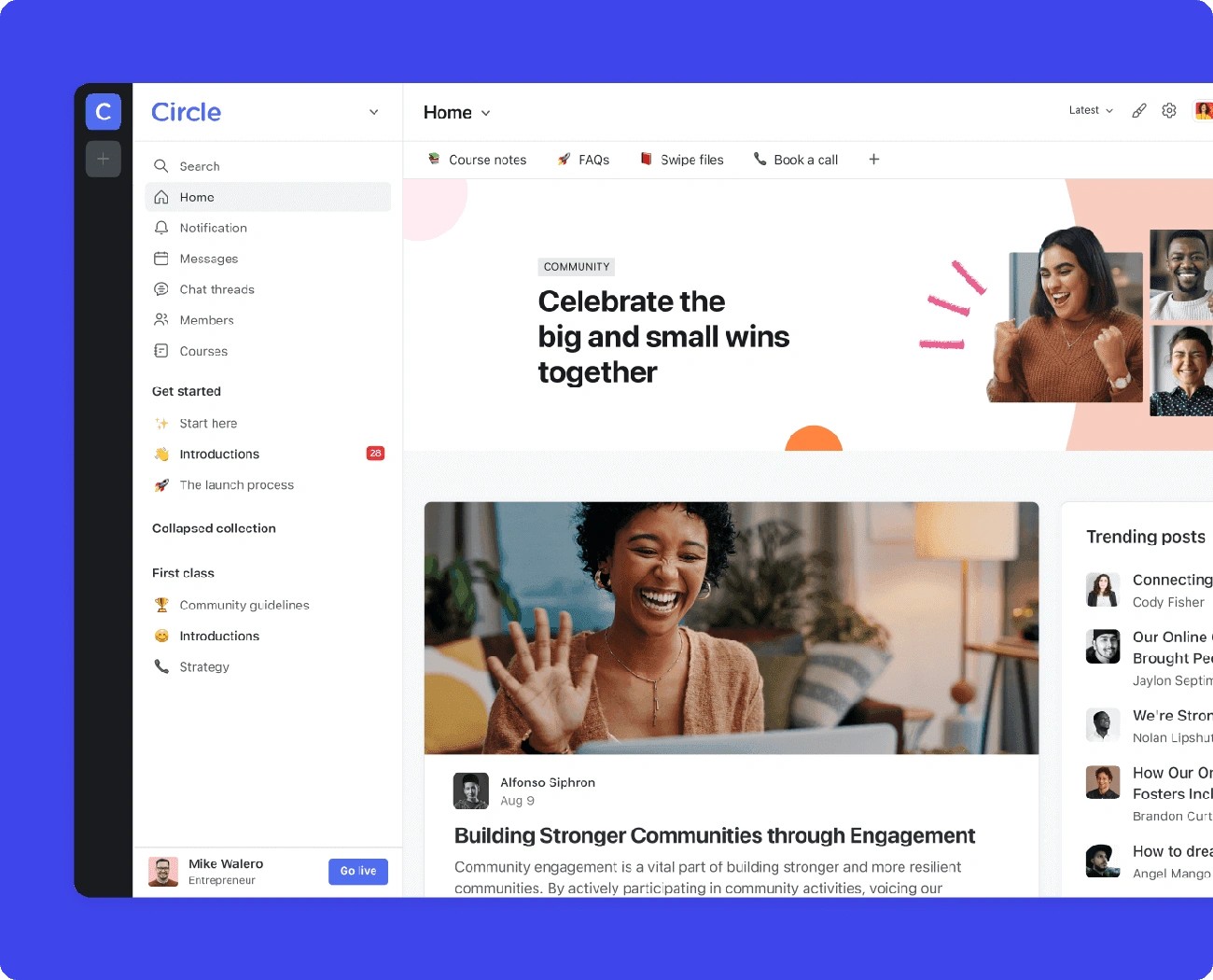
Image Source: Circle
“The most innovative creators are seeing their communities as accelerators for multiple revenue streams, not just subscription platforms. They’re using their communities to validate new products, gather instant feedback on ideas, and create exclusivity around premium offerings.” — Rudy Santino, Co-founder and Chief Design Officer, Circle
has grown into one of the most complete Circle.soonline community platforms worldwide trusted by over 15,000 communities[1]. Two former Teachable employees started the platform in 2020. They wanted to solve a common problem: creators used separate spaces for courses and community that didn’t work well together [2].
Key FeaturesCircle.so
The platform uses “Spaces” as its core building blocks. These are dedicated areas for specific topics or interactions that are the foundations of your community structure:
- Fully customizable design: You can match your brand identity by adjusting colors, logos, and layouts [1]
- Live streaming capabilities: The platform lets you host webinar-style events or Zoom-like calls [3]
- Built-in courses: You can create and sell structured lessons with videos, text, and downloadable materials [1]
- Events with RSVPs: Members can register for scheduled events and receive automated reminders [3]
- Native monetization: You can set up subscription access paywalls without needing third-party plugins [3]
- Mobile experience: Members stay connected through iOS and Android apps with push notifications [1]
The platform has added AI agents that can guide, coach, and help your community members around the clock. You can train these agents with your existing content to provide reliable support [1].
PricingCircle.so
The platform offers tiered pricing plans with annual discounts:
| Plan | Monthly Price | Transaction Fee | Key Limitations |
| Basic | $49 | 4% | 100 members, 10GB storage [4] |
| Professional | $99 | 2% | Unlimited members, 100GB storage [5] |
| Business | $219 | 1% | Workflows, API access [4] |
| Enterprise | $399 | 0.5% | Custom SSO, priority support [4] |
| Circle Plus | Custom pricing | 0.5% | Branded mobile apps [4] |
You get a 14-day free trial and a 30-day money-back guarantee with all plans [6]. Creators who want simpler monetization options without transaction fees might want to check out platforms like Rupa.
Pros and ConsCircle.so
Pros:
- User-friendly interface with excellent user experience [3]
- Extensive customization options for branding and community structure [1]
- One platform for courses, events, and live streaming [3]
- Powerful engagement tools including member profiles and direct messaging[3]
- Weekly digest emails that sum up community activity [3]
Cons:
- Higher pricing tier with transaction fees on all plans [7]
- Course features lack advanced assessment tools like quizzes and certificates [7]
- Fewer learning management features than dedicated LMS platforms [7]
- New users might feel overwhelmed by the many options available [1]
Best ForCircle.so
Circle shines when 3-year old creators and brands want a professional, branded community experience. The platform works great for:
- Course creators who want to add community features to their offerings
- Membership site owners who need flexible access controls for different tiers
- Brands ready to move from Facebook groups to a private, white-labeled space
Circle delivers best results for creators who have existing audiences and value design quality enough to invest in a premium experience. A customer success story shows how they in two years generated over $3 million through Circle[8], showing what’s possible with the platform.
Creators just starting out or focusing mainly on course creation might find simpler platforms like Rupa more suitable, especially when they need to verify product ideas with their audience first.
Mighty Networks
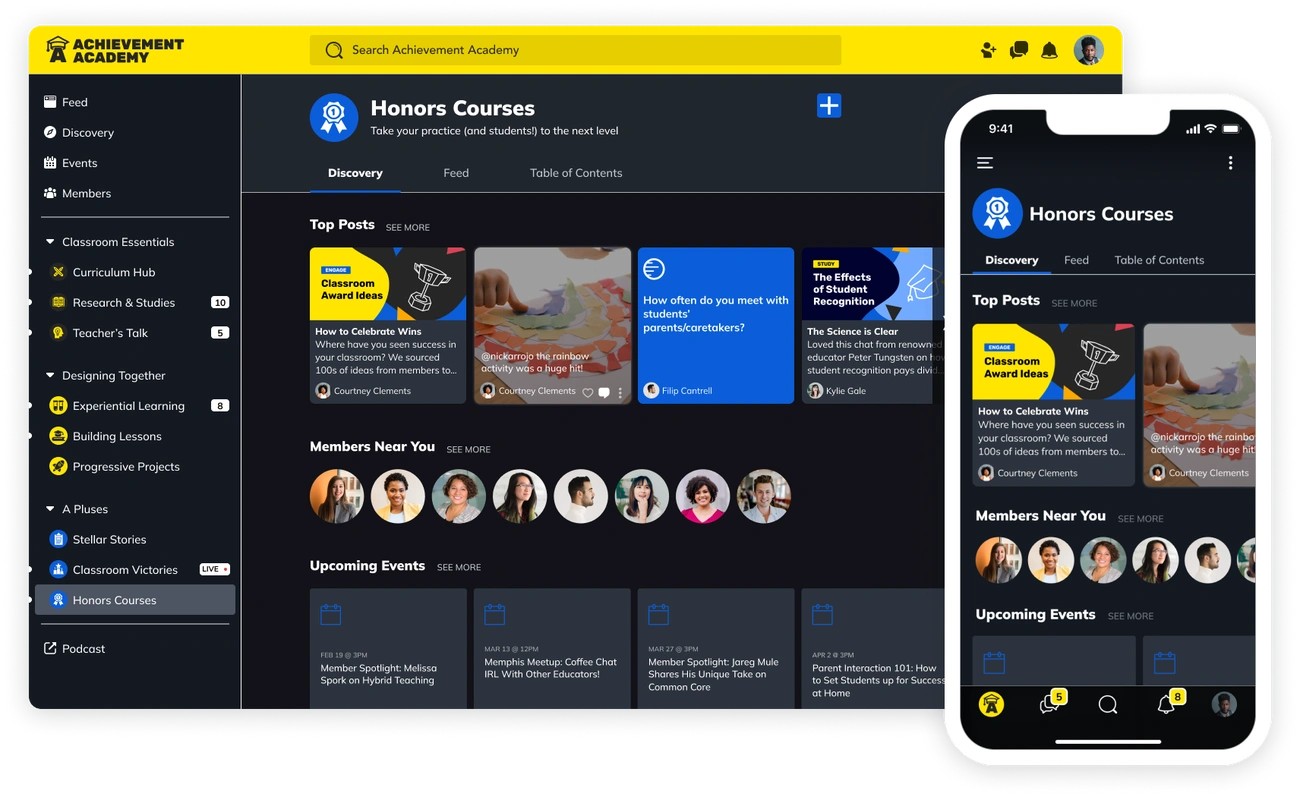
Image Source: Mighty Networks
Mighty Networks stands out among online community platforms by putting member connections ahead of content delivery. Gina Bianchini started the platform in 2017. Since then, it has grown into a thriving ecosystem that helps creators build meaningful connections with their audience.
Mighty Networks Key Features
The platform uses customizable “Spaces” as building blocks for your community. Here’s what you get:
- Dynamic Co-Host AI assistant powered by GPT-4 that helps create and manage your community
- Native courses and challenges with sequential, timed, or dripped content delivery
- Built-in gamification with streaks, points, and leaderboards to boost involvement
- Live streaming capabilities supporting multiple on-screen speakers simultaneously
- Member discovery tools including the unique “People Explorer” that connects relevant members
- Customizable branding lets you add your logo, colors, and branded banners
The “Show Similarities” feature is a great way to get members talking. It shows what people have in common and sparks natural conversations [3]. More than that, creators can make money through subscriptions, one-time payments, and custom subscription intervals in hundreds of currencies.
Mighty Networks Pricing
You can choose from four pricing tiers with annual discounts:
| Plan | Monthly Price | Annual Price | Transaction Fee | Storage |
| Community | $49 | $41 | 3% | 250GB |
| Courses | $119 | $99 | 2% | Not specified |
| Business | $219 | $179 | 2% | Not specified |
| Path-to-Pro | $360 | $360 (annual only) | 1% | Not specified |
Each plan comes with unlimited members, spaces, hosts, and moderators [9]. Platforms like Rupa might work better if you want simple monetization without transaction fees.
Mighty Networks Pros and Cons
Pros:
- No limit on members and community spaces in all plans [3]
- Great mobile apps for iOS and Android that users love [5]
- Rich engagement features with AI conversation starters and polls
- Built-in member referral system helps growth [6]
- The basic plan packs more features than competitors [5]
Cons:
- You pay transaction fees on all plans (1-3% based on tier) [9]
- Course features need work – no completion certificates or advanced quizzes [5]
- Limited integrations (mainly Stripe for payments, Zapier for connections) [5]
- The interface takes time to learn and can feel awkward [5]
- Marketing tools fall short compared to course-focused platforms [9]
Mighty Networks Best For
The platform shines when creators want to build active communities around shared interests. It works especially well for:
- Creators moving their followers from social media to a dedicated space [3]
- Coaches and teachers who combine memberships with courses
- Brands that want loyal customers through community building
Data shows paid communities on Mighty Networks perform better by a lot, with 60% more active members than free ones [4]. Creators with paid subscriptions earn about $1,000 monthly from 26 members paying $39.55 each [4].
If courses matter more than community, platforms like might fit better, especially with their simple course creation and automated marketing. Rupa’s AI Product Generator could also help you understand what your audience wants before building anything.Rupa
Swarm

Image Source: Swarm
Swarm stands out as the first video-powered community platform in the crowded online community space. Text-focused competitors can’t match Swarm’s approach of putting face-to-face interactions at the heart of community building.
Swarm Key Features
Swarm’s video-first approach creates a different kind of community experience:
- Asynchronous video messaging: Members share bite-sized video messages that build stronger connections than text alone [10]
- Live streaming capabilities: You can host events up to 90 minutes, and members who miss the live session can watch the automatic recordings [7]
- Auto-transcription: The system transcribes all audio and video conversations automatically, which makes content searchable and available [1]
- Screen sharing: You can record your screen and face at the same time, and move your face position as needed [1]
- Branded mobile app: A custom app helps boost member involvement [1]
- AI integration: The built-in AI assistant understands member questions and helps craft responses [1]
The platform tackles the “faceless” nature of traditional community platforms head-on. This results in compared to text-only alternatives twice the engagement[10].
Swarm Pricing
Swarm’s tiered pricing includes annual discounts (2 months free with yearly payment):
| Plan | Monthly Price | Members | Transaction Fee | Live Stream Duration |
| Launch | $39 | 1,000 | 10% | 30 min/session |
| Growth | $79 | 5,000 | 2% | 60 min/session |
| Scale | $149 | Unlimited | 0.5% | 90 min/session |
Each plan comes with unlimited courses, events, multi-tier memberships, and a branded digital store [7]. Creators looking for options without might want to check out Rupa’s simpler monetization structure.transaction fees
Swarm Pros and Cons
Pros:
- The video-centric approach creates stronger member connections [10]
- Text-based community platforms show lower engagement rates [10]
- Members can search video content for advice within the community [1]
- Support teams respond quickly (usually within 35 minutes) [1]
- New users get a guided checklist for smooth onboarding [1]
Cons:
- The basic plan has higher transaction fees than some competitors [7]
- Not all communities might work well with a video-first approach
- The platform is new and has fewer integrations
- Some members might need time to warm up to video
Swarm Best For
The sort of thing I love about Swarm is how well it works for specific creators:
- Coaches and consultants: Personal trainers and business coaches can show their techniques visually [1]
- Educational content creators: People who teach complex ideas that need more than just text
- Community builders focused on genuine connection: Leaders who want to build deep relationships
- Creators transitioning from YouTube/podcasts: People who feel comfortable with video and want to monetize their expertise [10]
Organizations like National University, ThriveDX, and vidIQ use Swarm for their communities [1]. In fact, if your content works better with visual demonstrations or you find text-based platforms limiting, Swarm could be the fresh approach you need for your community.
Skool
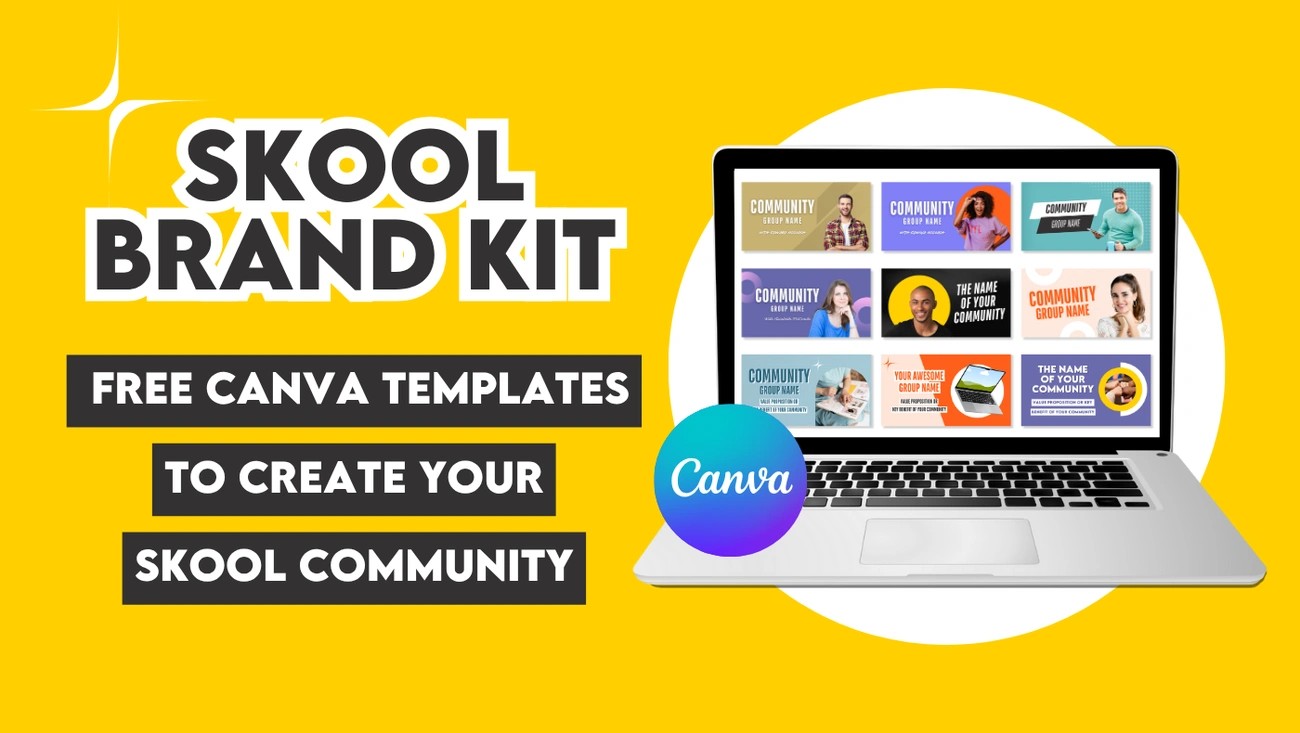
Image Source: Skool
Sam Ovens founded Skool in 2019, and it has grown into a online community platform focused on gamification. The platform made $26.60M in revenue by 2025 [11]. Skool stands out by taking a minimalist approach to community building that puts member interaction ahead of complicated features.
Skool Key Features
The platform organizes communities around six easy-to-use components:
- Community Feed: Members connect in this central forum to post questions, celebrate wins, and interact through likes, comments, and mentions
- Classroom: A space to create courses with modules, embedded videos, resources, and track progress
- Calendar: Schedule events with automatic timezone conversion for everyone
- Gamification System: Members compete through points, levels, and leaderboards to boost interaction
- Native Video Hosting: The platform added automatic captions, timestamps, and playback controls
- Email Broadcasts: Send community posts to all members via email with one click
The platform’s gamification system lets creators , which makes participation more rewarding tie course access to how much members interact[2].
Skool Pricing
The platform keeps pricing simple with two plans:
| Plan | Monthly Price | Transaction Fee | Admin Accounts |
| Hobby | $9 | 10% | 1 |
| Pro | $99 | 2.9% | Unlimited |
Both plans come with unlimited members and courses [12]. This flat-rate pricing makes the platform budget-friendly for growing communities since prices stay the same whatever the member count.
Skool Pros and Cons
Pros:
- Simple interface that takes minutes to learn
- Gamification features that substantially increase member activity
- Fixed pricing no matter how big your community grows
- Transaction fees (2.9%) are lower than Discord (16%) and Patreon (14%)[12]
- Strong mobile apps for iOS and Android users
Cons:
- Basic course features without quizzes, certificates, or progress tracking
- Few options to customize your branding
- You need external platforms for video hosting
- Missing marketing tools like sales funnels or checkout options
- Only connects with Zapier and webhooks
Skool Best For
My testing shows Skool shines for:
- Coaches and consultants ready to move from free social media content to paid memberships
- Content creators who want to build active communities around shared interests
- People who prefer simplicity over complex features
- Businesses that need to grow without worrying about per-member costs
Creators who need better marketing tools or funnel features might want to look at platforms like Rupa. These can handle sales and marketing while Skool takes care of the community side.
GroupApp
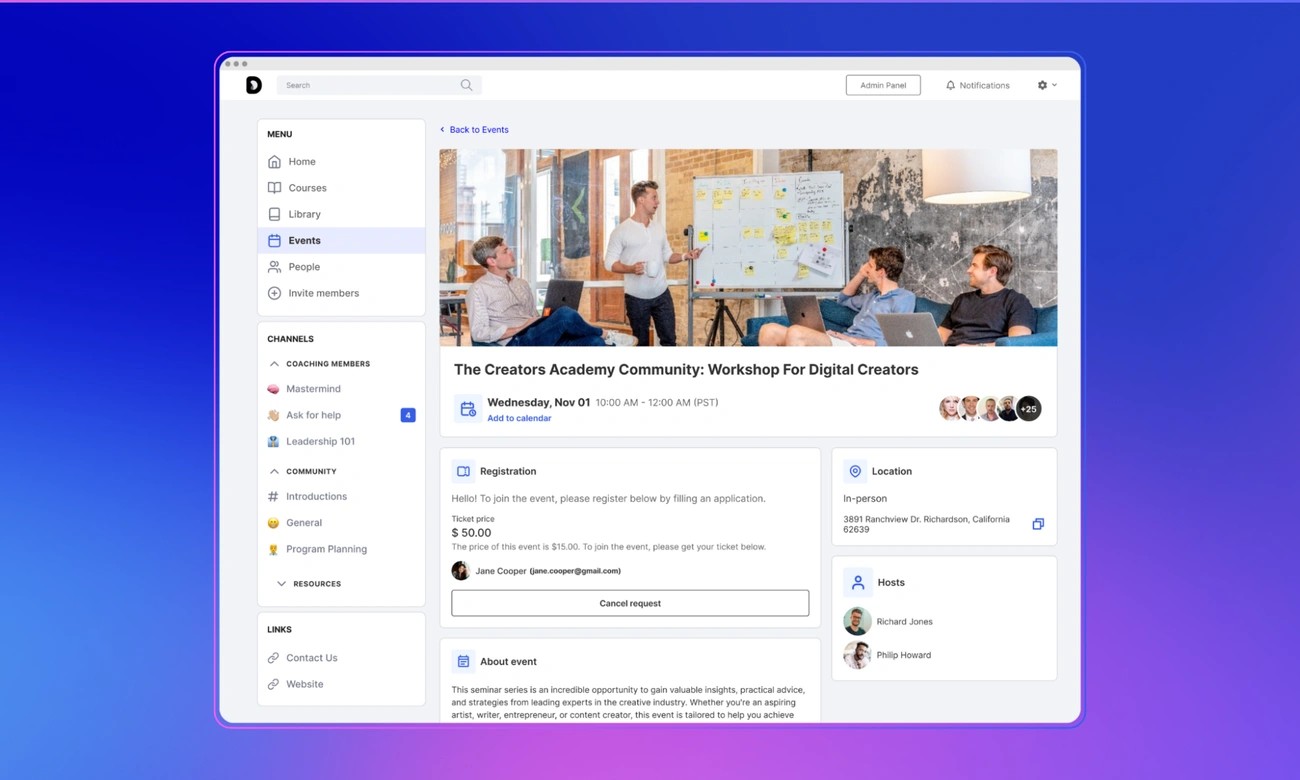
Image Source: GroupApp
GroupApp is a complete online community platform that brings courses, community, and payments together in one unified dashboard. , this platform puts user experience first for both creators and members Trusted by over 1,100 learning programs[13].
GroupApp Key Features
GroupApp’s features create a social-first, branded learning environment:
- Discussion Tools: Structured conversations with channels, activity feed, and direct messaging that build deeper connections
- Events Calendar: Built-in event hosting with RSVP management, calendar sync, and automated reminders
- Resource Library: Centralized hub for videos, PDFs, audio files that includes filtering and categorization options
- Course Creation: Drag-and-drop builder that supports multiple content formats including quizzes, assignments, and certificates
- Monetization Options: Sell memberships, courses, and events through custom checkout pages and promotional codes
- Workflows Automation: Create individual-specific experiences based on specific triggers and actions
GroupApp also lets you customize your branding with custom domain support, theme colors, and branded mobile apps for both iOS and Android [13].
GroupApp Pricing
The platform offers clear pricing without hidden transaction fees:
| Plan | Monthly Price | Annual Price | Storage | Key Features |
| Starter | $39/month | $468/year | 10GB | Unlimited courses, custom domain |
| Pro | $99/month | $1,188/year | 100GB | Workflows, scheduling, white-labeling |
| Business | Custom | Custom | 200GB | Advanced support, higher usage limits |
Note that all plans come with 0% transaction fees, so creators keep 100% of their earnings [14].
GroupApp Pros and Cons
Pros:
- Accessible interface that makes community management straightforward [8]
- All-in-one solution that combines courses, community, and membership features [8]
- Zero transaction fees on all paid plans that let creators keep their revenue [14]
- Strong content organization through channels and library tools [8]
- Detailed analytics to track community performance and engagement [8]
Cons:
- White-label solution unavailable for enterprise needs
- Limited PayPal integration for payments
- Mobile app needs improvement
- Live streaming functionality missing
- No built-in referral program [15]
GroupApp Best For
GroupApp works best for creators who want to build learning-centered communities:
- Course creators who want community elements without multiple platforms
- Coaches and consultants building cohort-based programs with integrated payments
- Content creators moving from social platforms to owned community spaces
- Businesses creating membership sites with tiered access to premium content
User reports show that creators have built six-figure membership communities within a year using GroupApp [16]. This makes it valuable for anyone serious about monetizing their expertise.
Kajabi
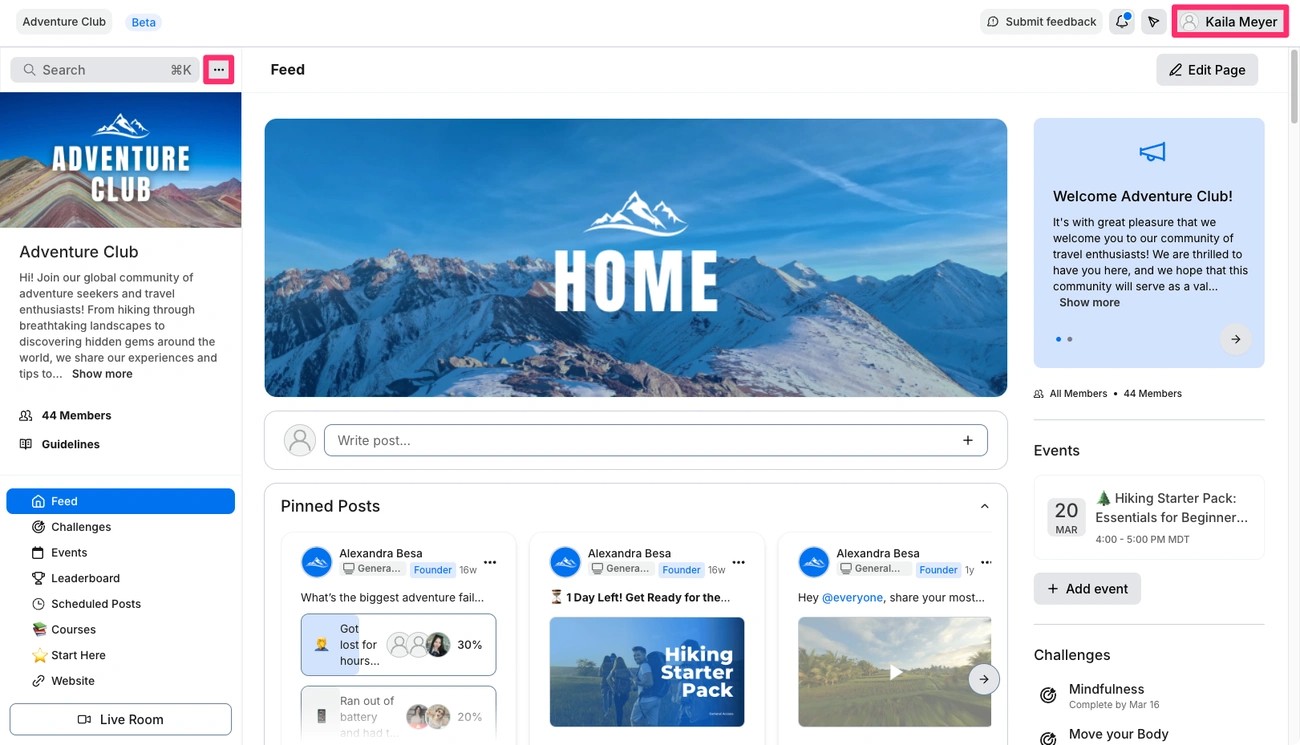
Image Source: Kajabi Help Center
“Top-tier influencers and creators—especially those with multiple income streams—can earn anywhere from $50,000 to $200,000 per month or more.” — Rudy Santino, Co-founder and Chief Design Officer, Circle
Kajabi stands out as an all-in-one knowledge commerce platform that combines powerful tools to create, market, and sell digital products. The platform has helped creators earn over $10 billion in revenue[17]. Almost 15,000 users have built six-figure businesses through the platform [17].
Kajabi Key Features
The platform’s complete ecosystem provides several ways to monetize:
- Course Creation: Drag-and-drop builder with video hosting and student progress tracking
- Community Building: Channels for focused discussions, member directories, and leaderboards [18]
- Website Builder: No-code site creation with customizable themes and landing pages
- Email Marketing: Automated campaigns, segmentation, and analytics
- Payment Processing: Native checkout through Kajabi Payments with multiple payment options
- Mobile Experience: Branded app for both creators and customers [19]
Kajabi has added AI-powered tools that include newsletters and content creation assistance, making the platform even more valuable for creators who want to monetize their knowledge.
Kajabi Pricing
The platform comes with four pricing tiers and annual discounts:
| Plan | Monthly Price | Annual Price | Products | Contacts | Key Features |
| Kickstarter | $89 | $71 | 1 | 250 | 1 website, AI tools [20] |
| Basic | $179 | $143 | 5 | 2,500 | Custom domain [20] |
| Growth | $249 | $199 | 50 | 25,000 | 10 admin users [20] |
| Pro | $499 | $399 | Unlimited | 100,000 | 3 websites [20] |
The platform doesn’t take a cut of creator revenue [17]. Standard payment processing fees (2.7-2.9% + $0.30 per transaction) still apply [20].
Kajabi Pros and Cons
Pros:
- Complete all-in-one solution that replaces multiple tools [6]
- No revenue sharing – creators keep 100% of sales [17]
- Strong email marketing with segmentation capabilities [9]
- Powerful analytics and reporting tools
- Optimized tech stack where everything works together [3]
Cons:
- Higher price point than single-function alternatives [6]
- Steeper learning curve because of extensive features
- Limited flexibility in design customization [6]
- Simple blog functionality compared to dedicated platforms [6]
- No inventory tracking for physical products [21]
Kajabi Best For
Kajabi excels for knowledge entrepreneurs who need a complete business solution. The average six-figure creator on Kajabi has about 465 customers who pay $449 yearly[17]. These numbers show its potential to generate substantial revenue.
The platform works best for coaches, course creators, and membership site owners who want everything in one place and can invest in a strong platform. Creators just starting out or those who need simpler tools might find Rupa a better fit to monetize their expertise.
Bettermode
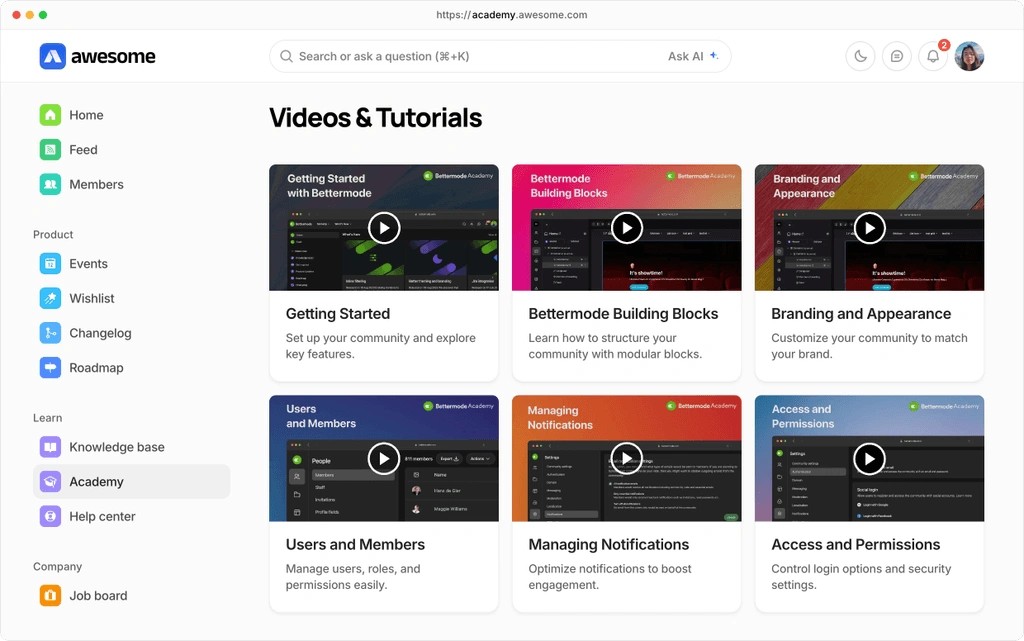
Image Source: bettermode.com
Bettermode stands out as a versatile online community platform that helps businesses promote deeper customer connections and accelerate community-led growth [22]. The platform, previously known as , helps organizations create powerful hubs quickly and deliver better customer experiences.Tribe.so
Bettermode Key Features
The platform centers around flexible “Spaces” to organize community content:
- A customizable design studio lets you build unique, branded communities without code [23]
- Members can participate through reactions, comments, personalized feeds, and private messaging [5]
- Analytics tools track engagement, member growth, and content performance [5]
- The platform connects with business tools like HubSpot, Salesforce, and Zendesk [23]
- A developer portal enables custom solutions and automations [24]
Communities can be or websites, which substantially increases adoption embedded directly into existing mobile apps[25].
Bettermode Pricing
| Plan | Monthly Cost | Best For | Key Features |
| Advanced | $599 | Growing brands | API access, SSO, white-label |
| Enterprise | Custom | Large/regulated businesses | Security features, audit logs, data residency |
Both plans come with core features like theme customization, analytics, and moderation tools [5].
Bettermode Pros and Cons
Pros:
- Rich customization options for branding and community structure [5]
- Resilient engagement and moderation tools [5]
- Continuous connection with existing business processes [26]
Cons:
- The price point is higher than alternatives [27]
- Mobile features are not fully available [27]
- Beginners might find the extensive features overwhelming [5]
Bettermode Best For
Mid-market and enterprise businesses with established customer bases will benefit most from Bettermode. Software companies, consumer products and services businesses, and e-commerce stores with more than 50 employees [23] are ideal users. Creators who are just starting out or need simpler monetization options should consider platforms like Rupa that offer more affordable alternatives.
Thinkific
Image Source: Thinkific
Thinkific is a reliable platform that gives course creators total control over their learning experience. This powerful online learning management system helps educators earn substantial income by sharing their knowledge.
Thinkific Key Features
Thinkific provides a complete set of tools focused on learning experiences:
- Online learning communities with custom-branded spaces that connect students [28]
- No-code mobile app builder that delivers content through branded iOS/Android apps [28]
- Drag-and-drop course builder lets you create professional courses without technical skills [29]
- Marketing and sales tools including website builder and promotional features [28]
- Student engagement features like certificates, assignments, and community spaces [4]
Thinkific Pricing
Thinkific offers tiered pricing with 25% discount on annual plans[30]:
| Plan | Monthly Price | Annual Price | Key Offerings |
| Basic | $49 | $36 | Unlimited courses, coupons, live lessons [29] |
| Start | $99 | $74 | Communities, assignments, advanced reporting [29] |
| Grow | $199 | $149 | Bulk emailing, API access, white labeling [29] |
| Plus | Custom | Custom | Unlimited everything, dedicated support [29] |
Thinkific Pros and Cons
Pros:
- You control course design, pricing, and student data completely [28]
- The platform supports various content types with a user-friendly interface [4]
- Strong community features come with mobile notifications [31]
Cons:
- Higher-tier plans lock many advanced features [4]
- Email marketing capabilities need third-party integrations [4]
- Videos take 30-60 minutes to upload [32]
Thinkific Best For
Educators, coaches, and businesses use Thinkific to monetize through structured online learning. The platform works best for those who value professional course delivery over community-first approaches. Rupa’s AI Product Generator provides a quicker way to validate products before building courses.
Podia
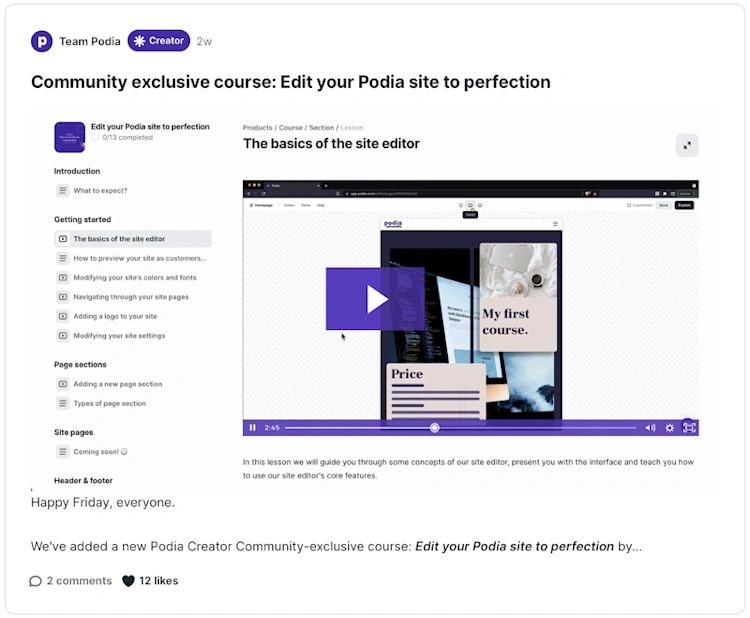
Image Source: Podia
Podia is a simple online community platform that helps over 150,000 creators from 167 countries earn more than $500 million collectively [33].
Podia Key Features
The platform makes digital product sales and community building efficient:
- Community spaces with topics, posts, and comments to boost member participation [34]
- Website builder with drag-and-drop functionality and custom domain support [1]
- Product versatility including online courses, digital downloads, webinars, and coaching [1]
- Email marketing as a adaptable add-on based on subscriber count [35]
- Affiliate program tools on higher-tier plans to grow through mutually beneficial alliances [36]
Podia merges community features with other products. Creators can bundle access or build standalone membership sites without technical hurdles [34].
Podia Pricing
The platform offers clear pricing options:
| Plan | Monthly | Annual | Transaction Fee |
| Free | $0 | $0 | 10% |
| Mover | $39 | $33 | 5% |
| Shaker | $89 | $75 | 0% |
The email marketing add-on starts free for up to 100 subscribers and grows with your list size [37].
Podia Pros and Cons
Pros:
- User-friendly interface that’s easy to learn [1]
- All-in-one solution that combines multiple tools [1]
- Unlimited products with all paid plans [7]
- Support available 7 days a week [35]
Cons:
- Mover plan’s 5% transaction fee cuts into profits [1]
- Limited options for design and brand customization [1]
- Simple community features compared to specialized platforms [1]
Podia Best For
The platform works best for beginners and early-stage creators who want to launch without technical complications [1]. Course creators, coaches, and content creators moving from social platforms will appreciate Podia’s simplicity [38]. Creators who need advanced community features can use Rupa’s complementary tools that focus on audience monetization and simple product creation.
Comparison Table
| Platform | Starting Price | Transaction Fee | Key Features | Best For | Notable Pros | Notable Cons |
| Circle.so | $49/month | 4% (Simple) – 0.5% (Enterprise) | – Customizable spaces- Live streaming- Built-in courses- Events with RSVPs- Native monetization | – 3-year-old creators- Course creators- Membership site owners | – Easy-to-use- Strong customization- Integrated courses | – Higher pricing- Limited course features |
| Mighty Networks | $49/month | 3% – 1% | – Dynamic Co-Host AI- Native courses- Built-in gamification- Live streaming | – Content creators- Coaches- Community-focused brands | – Unlimited members- Strong mobile apps- Rich engagement features | – Transaction fees on all plans- Limited integrations |
| Swarm | $39/month | 10% – 0.5% | – Video messaging- Auto-transcription- Screen sharing- Branded mobile app | – Coaches/consultants- Educational creators- Video content creators | – Higher engagement rates- Video-centric approach- Searchable content | – High starter plan fees- Limited integrations |
| Skool | $9/month | 10% (Hobby) – 2.9% (Pro) | – Community feed- Classroom- Calendar- Gamification system | – Coaches- Community builders- Content creators | – Easy-to-use- Strong gamification- Flat-rate pricing | – Limited course features- Minimal customization |
| GroupApp | $39/month | 0% | – Discussion tools- Events calendar- Resource library- Course creation | – Course creators- Coaches- Consultants | – No transaction fees- All-in-one solution- Strong analytics | – No white-label option- Limited PayPal integration |
| Kajabi | $89/month | Payment processing only (2.7-2.9%) | – Course creation- Website builder- Email marketing- Payment processing | – Experienced knowledge entrepreneurs- Course creators | – Complete solution- No revenue sharing- Strong marketing tools | – Higher price point- Steep learning curve |
| Bettermode | $599/month | Not mentioned | – Customizable design- Engagement tools- Built-in analytics- Business integrations | – Mid-market businesses- Enterprise companies | – Extensive customization- Strong integrations | – Higher pricing- Complex for beginners |
| Thinkific | $49/month | Not mentioned | – Online communities- Mobile app builder- Course builder- Marketing tools | – Educators- Coaches- Businesses | – Full control- Easy-to-use | – Feature limitations- Slow video uploads |
| Podia | Free – $89/month | 10% – 0% | – Community spaces- Website builder- Product versatility- Email marketing | – Beginners- Early-stage creators | – User-friendly- All-in-one solution- Unlimited products | – Simple features- Limited customization |
Conclusion
Creators need the right online community platform to build steady income streams. I tested nine platforms extensively and found that each has its own strengths based on what you want to achieve. shines with its rich features and professional design. Mighty Networks does a great job with relationship-building tools. Video-focused creators might prefer Swarm, while Skool works well for those who value simplicity and gamification.Circle.so
The platforms charge different transaction fees that can affect your earnings. GroupApp takes 0% while some basic plans want 10% of your revenue. This makes a big difference as your community grows. Our comparison shows that pricier options like Kajabi and Bettermode give you more complete business tools, but they take longer to learn.
Your audience size, content type, and money-making approach will guide your choice. Most successful creators I talked to use multiple platforms together to earn more. . The easiest way for creators to turn followers into paying customers.Find out what your followers actually want to buy and launch it fast with Rupa
A thriving online community needs regular work, but the right platform makes things easier. Many creators in this piece started small and grew to six figures. They focused on giving real value before thinking about making money. No matter which platform you pick, genuine connections are the foundations of steady creator income. Your expertise deserves the perfect home—one that connects you with your audience and pays you fairly for your value.
Key Takeaways
These insights will help you choose the right community platform to monetize your expertise and build sustainable creator income.
• Transaction fees matter significantly: Platforms range from 0% (GroupApp) to 10% (basic plans), directly impacting your revenue as you scale your community.
• Video-first platforms like Swarm generate 2x higher engagement than text-only alternatives, making them ideal for coaches and educators who demonstrate concepts visually.
• Successful creators combine multiple tools rather than relying on single platforms to maximize monetization potential and audience reach.
• Gamification drives results: Platforms with points, levels, and leaderboards (like Skool) create 60% more active members in paid communities.
• Start simple, then scale: Begin with user-friendly platforms like Podia or Skool before moving to comprehensive solutions like Kajabi as your business grows.
The most successful creators focus on delivering genuine value first, then optimize their monetization strategy. Your platform choice should align with your content type, audience size, and long-term business goals rather than just features or pricing alone.
FAQs
Q1. What is the best platform for building an online community in 2025? The best platform depends on your specific needs, but , Mighty Networks, and GroupApp are top contenders for comprehensive community-building features, engagement tools, and monetization options.Circle.so
Q2. How do video-centric platforms like Swarm compare to text-based alternatives? Video-centric platforms like Swarm typically generate twice the engagement compared to text-only alternatives, making them ideal for visual content creators, coaches, and educators who need to demonstrate concepts.
Q3. Are there any community platforms that don’t charge transaction fees? Yes, GroupApp stands out by charging 0% transaction fees on all plans, allowing creators to keep 100% of their earnings. Some other platforms offer plans with no transaction fees at higher pricing tiers.
Q4. Which platform is best for creators just starting out? For beginners, user-friendly platforms like Podia or Skool offer a good balance of features and simplicity. They provide essential tools for community building and monetization without overwhelming new creators.
Q5. How important is gamification in online communities? Gamification can significantly boost engagement. Platforms with features like points, levels, and leaderboards (such as Skool) have been shown to create 60% more active members in paid communities compared to those without such features.
References
[1] – https://www.group.app/blog/podia-review/
[2] – https://bloggingx.com/skool-review/
[3] – https://kajabi.com/blog/when-is-the-right-time-to-sign-up-for-kajabi
[4] – https://www.schoolmaker.com/blog/thinkific-review
[5] – https://b2bsaasreviews.com/products/bettermode/
[6] – https://louisehenry.com/blog/kajabi-review-2025
[7] – https://www.podia.com/pricing
[8] – https://www.group.app/blog/membership-apps/
[9] – https://kajabi.com/blog/what-is-segmentation-why-should-you-use-it
[10] – https://swarm.to/
[11] – https://getlatka.com/companies/skool.com
[12] – https://www.skool.com/pricing
[13] – https://www.group.app/
[14] – https://www.group.app/pricing/
[15] – https://blog.groupleads.net/groupapp-review/
[16] – https://www.group.app/blog/membership-pricing/
[17] – https://kajabi.com/10b
[18] – https://communityinsiders.mykajabi.com/blog/kajabicommunitiesforbeginners
[19] – https://kajabi.com/features
[20] – https://kajabi.com/pricing
[21] – https://www.jordanoutside.com/kajabi-review
[22] – https://bettermode.com/
[23] – https://bettermode.com/blog/bettermode-vs-insided
[24] – https://bettermode.com/product/feature-index-bettermode
[25] – https://bettermode.com/blog/all-in-one-community-platform
[26] – https://wbcomdesigns.com/bettermode-review/
[27] – https://www.g2.com/products/bettermode/reviews?qs=pros-and-cons
[28] – https://www.thinkific.com/blog/content-monetization-platforms/
[29] – https://www.thinkific.com/blog/best-online-course-platforms/
[30] – https://www.mihaelcacic.com/pricing-analysis/thinkific-pricing/
[31] – https://support.thinkific.com/hc/en-us/articles/13489201576983-Supported-Community-Features
[32] – https://www.getresponse.com/blog/thinkific-review
[33] – https://www.podia.com/affiliates
[34] – https://www.podia.com/community
[35] – https://www.uscreen.tv/blog/podia-vs-kajabi/
[36] – https://www.podia.com/articles/how-to-create-an-affiliate-program
